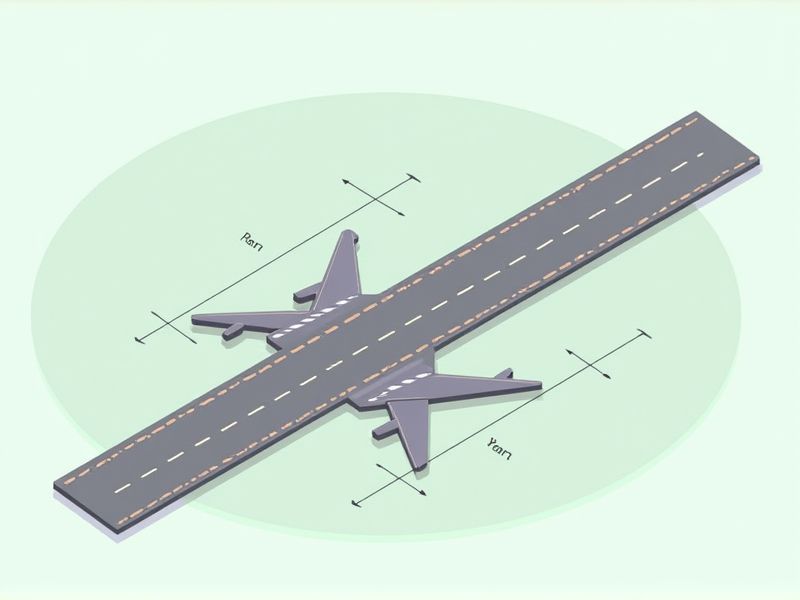
Airport runway dimensions can vary greatly depending on the size and type of aircraft the airport serves. For most international airports, runways typically range from 2,500 to 4,000 meters (about 8,200 to 13,100 feet) in length and are usually 45 to 60 meters (about 150 to 200 feet) wide. Smaller airports designed for regional or general aviation traffic often have shorter runways, ranging from 1,000 to 2,500 meters (about 3,300 to 8,200 feet) in length. Knowing the standard runway dimensions is useful for pilots and airport planners to ensure safe takeoff and landing operations for different kinds of aircraft.
Runway Length
Runway length is a critical factor determining the operational capacity and safety of airports. Typically, commercial jet runways range from 3,000 to 13,000 feet, with longer runways accommodating larger aircraft and heavier loads. For example, a runway length of 10,000 feet allows for takeoffs and landings under various weather conditions and at high altitudes. Understanding the requirements of the specific aircraft type and its weight can help you evaluate the necessary runway length for optimal performance and safety.
Runway Width
Runway width is a critical factor in airport design, ensuring adequate safety and performance for aircraft during takeoffs and landings. The Federal Aviation Administration (FAA) recommends a minimum runway width of 150 feet for larger aircraft, such as commercial jets, while smaller general aviation airports may have runways as narrow as 75 feet. These dimensions help reduce the risk of runway excursions and provide sufficient clearance for wingspan and maneuverability. Understanding the importance of runway width can enhance safety protocols and operational efficiency at any airport facility.
Runway Shoulders
Airport runway shoulders, typically measuring 7.5 to 10 feet wide, play a vital role in enhancing safety and operational efficiency. These areas, located alongside the runway, provide structural support, helping to prevent aircraft from veering off the runway during takeoff or landing. Regular maintenance of runway shoulders, including prompt repairs and vegetation control, ensures compliance with FAA regulations and optimizes performance. You can significantly reduce risks by ensuring that runway shoulders are maintained to the highest standards, providing crucial safety margins for aircraft operations.
Runway Safety Area
The Runway Safety Area (RSA) is a critical component in airport runway design, mandated by international regulations to enhance safety and minimize accident risk. An RSA typically extends 150 feet from the runway centerline and is designed to support the weight of aircraft should they overshoot, undershoot, or veer off the runway. Maintaining a clear and obstacle-free RSA allows for safer operations, reducing the likelihood of collisions and providing space for emergency maneuvers. For optimal safety, your airport must adhere to these dimensions and guidelines, ensuring proper maintenance and monitoring of runway surroundings.
Runway End Safety Area
The Runway End Safety Area (RESA) is a critical component of airport runway design, typically extending at least 90 meters (295 feet) from the runway end when conditions permit. RESAs are engineered to minimize the consequences of an aircraft overshooting or departing from the runway, providing a safer environment for both passengers and crew. According to the Federal Aviation Administration (FAA), an effective RESA can significantly reduce the risk of injuries and fatalities during runway excursions. Implementing these safety areas aligns with global aviation safety standards, enhancing operational safety and efficiency at airports.
Taxiway Dimensions
Taxiway dimensions are critical for maintaining the safety and efficiency of airport operations, with standard widths typically ranging from 75 feet (22.86 meters) to 100 feet (30.48 meters) for most major airports. The Federal Aviation Administration (FAA) recommends a minimum separation of 400 feet (121.92 meters) between parallel taxiways to accommodate large aircraft movements. Furthermore, the design must consider the radii of taxiway curves, which often require a minimum of 75 feet (22.86 meters) to facilitate smooth turns without compromising the aircraft's operational integrity. Ensuring that your airport's taxiway adheres to these established standards is essential for optimizing ground traffic flow and enhancing overall safety.
Distance Between Parallel Runways
The standard distance between parallel runways is typically 4,300 feet (1,310 meters) for commercial airports, which ensures safe operations during takeoffs and landings. In some cases, this distance can vary based on local regulations and specific airport designs. For instance, airports may require increased separation for runways that accommodate heavy aircraft or for those with specific weather conditions. Understanding these measurements is crucial for aviation professionals and airport planners to maintain safety and efficiency in air traffic operations.
Obstacle Limitation Surfaces
The Obstacle Limitation Surfaces (OLS) are critical in ensuring the safety and operational efficiency of airport runways. OLS delineates specific areas that must remain free of obstacles to allow safe takeoff and landing trajectories for aircraft. According to FAA standards, these surfaces often extend 150 feet in height for a distance of 3,000 feet from the runway threshold. Ensuring compliance with OLS requirements minimizes risk for pilots and enhances overall airport safety.
Runway Markings
Runway markings are critical for safe aircraft operations, ensuring pilots can accurately identify runways, taxiways, and important zones. Specifically, these markings include threshold markings, centerlines, and aiming points, each measuring 10 to 12 feet in width and designed for high visibility. The Federal Aviation Administration (FAA) standards mandate that these markings adhere to specific color codes, primarily white for runways, to enhance visibility under various weather conditions. By understanding runway markings, you can improve your situational awareness during takeoff and landing, significantly contributing to aviation safety.
Runway Gradient
Runway gradient is crucial for airport design, with recommended slopes ranging from 1% to 2% to ensure optimal drainage and safety during takeoff and landing. Adhering to these standards helps prevent water accumulation, which can create hazardous conditions for aircraft. Inadequate gradient can lead to operational challenges; for example, a runway with a gradient over 2% may complicate heavy aircraft operations, increasing wear and tear on landing gear. Consequently, precise design and maintenance of runway gradients are vital for maximizing the efficiency and safety of airport operations.
